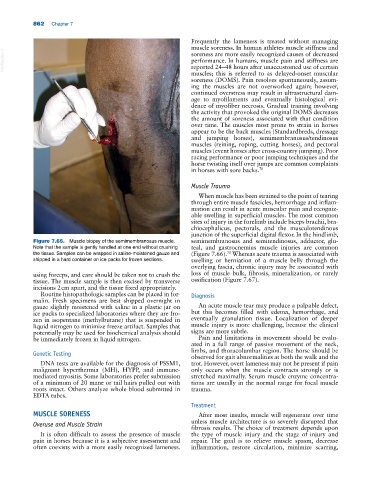Page 896 - Adams and Stashak's Lameness in Horses, 7th Edition
P. 896
862 Chapter 7
Frequently the lameness is treated without managing
muscle soreness. In human athletes muscle stiffness and
VetBooks.ir performance. In humans, muscle pain and stiffness are
soreness are more easily recognized causes of decreased
reported 24–48 hours after unaccustomed use of certain
muscles; this is referred to as delayed‐onset muscular
soreness (DOMS). Pain resolves spontaneously, assum
ing the muscles are not overworked again; however,
continued overstress may result in ultrastructural dam
age to myofilaments and eventually histological evi
dence of myofiber necrosis. Gradual training involving
the activity that provoked the original DOMS decreases
the amount of soreness associated with that condition
over time. The muscles most prone to strain in horses
appear to be the back muscles (Standardbreds, dressage
and jumping horses), semimembranosus/tendinosus
muscles (reining, roping, cutting horses), and pectoral
muscles (event horses after cross‐country jumping). Poor
racing performance or poor jumping techniques and the
horse twisting itself over jumps are common complaints
in horses with sore backs. 70
Muscle Trauma
When muscle has been strained to the point of tearing
through entire muscle fascicles, hemorrhage and inflam
mation can result in acute muscular pain and recogniz
able swelling in superficial muscles. The most common
sites of injury in the forelimb include biceps brachii, bra
chiocephalicus, pectorals, and the musculotendinous
junction of the superficial digital flexor. In the hindlimb,
Figure 7.65. Muscle biopsy of the semimembranosus muscle. semimembranosus and semitendinosus, adductor, glu
Note that the sample is gently handled at one end without crushing teal, and gastrocnemius muscle injuries are common
the tissue. Samples can be wrapped in saline‐moistened gauze and (Figure 7.66). Whereas acute trauma is associated with
70
shipped in a hard container on ice packs for frozen sections. swelling or herniation of a muscle belly through the
overlying fascia, chronic injury may be associated with
using forceps, and care should be taken not to crush the loss of muscle bulk, fibrosis, mineralization, or rarely
tissue. The muscle sample is then excised by transverse ossification (Figure 7.67).
incisions 2 cm apart, and the tissue fixed appropriately.
Routine histopathologic samples can be placed in for Diagnosis
malin. Fresh specimens are best shipped overnight in
gauze slightly moistened with saline in a plastic jar on An acute muscle tear may produce a palpable defect,
ice packs to specialized laboratories where they are fro but this becomes filled with edema, hemorrhage, and
zen in isopentane (methylbutane) that is suspended in eventually granulation tissue. Localization of deeper
liquid nitrogen to minimize freeze artifact. Samples that muscle injury is more challenging, because the clinical
potentially may be used for biochemical analysis should signs are more subtle.
be immediately frozen in liquid nitrogen. Pain and limitations in movement should be evalu
ated in a full range of passive movement of the neck,
limbs, and thoracolumbar region. The horse should be
Genetic Testing
observed for gait abnormalities at both the walk and the
DNA tests are available for the diagnosis of PSSM1, trot. However, overt lameness may not be present if pain
malignant hyperthermia (MH), HYPP, and immune‐ only occurs when the muscle contracts strongly or is
mediated myositis. Some laboratories prefer submission stretched maximally. Serum muscle enzyme concentra
of a minimum of 20 mane or tail hairs pulled out with tions are usually in the normal range for focal muscle
roots intact. Others analyze whole blood submitted in trauma.
EDTA tubes.
Treatment
MUSCLE SORENESS After most insults, muscle will regenerate over time
Overuse and Muscle Strain unless muscle architecture is so severely disrupted that
fibrosis results. The choice of treatment depends upon
It is often difficult to assess the presence of muscle the type of muscle injury and the stage of injury and
pain in horses because it is a subjective assessment and repair. The goal is to relieve muscle spasm, decrease
often coexists with a more easily recognized lameness. inflammation, restore circulation, minimize scarring,

